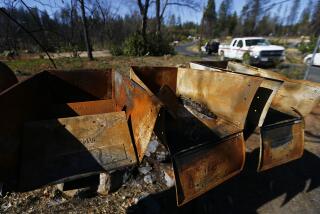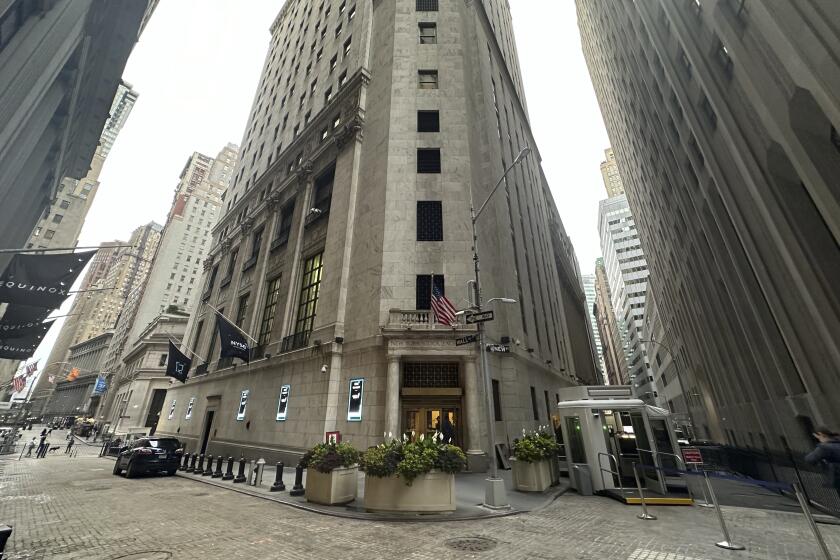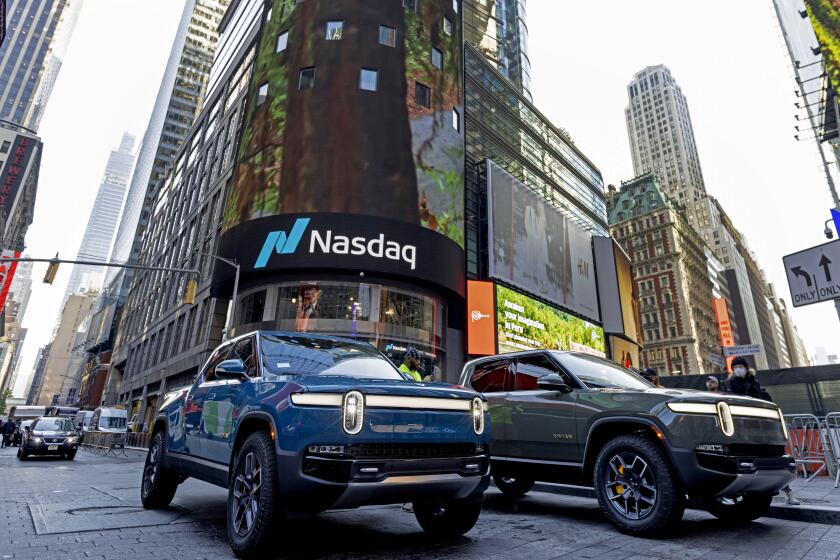Buyout Hits the Bull’s Eye at Colt’s : Co-Ownership Triggers New Era for Gun Maker
For decades, the strife between management and unionized workers at the two Colt Firearms plants here was so bitter that the handguns, military rifles and grenade launchers they made could have been symbols for the rancor.
Exploding dynamite all but leveled the company president’s home during a strike in 1935. And after that, strikes, walkouts and job actions punctuated periods of uneasy coexistence. The depth of the hard feelings was made clear again in the late 1980s. Workers went on strike in 1986 and stayed out for more than four years.
In the past 12 months, however, this ugly relationship has undergone a remarkable transformation.
Last December, management and workers held the first joint Christmas party that anyone can remember. A joint picnic is planned for June. Workers write to the chief executive saying how much they enjoy coming to work. The company now solicits advice from workers on design changes and is modifying products and production techniques at employees’ suggestion. Management has begun taking assembly workers along to trade shows.
And Lester Harding, the taciturn United Auto Workers shop chairman who stubbornly led the years-long strike, now spends much of his time exhorting workers to work harder and sitting in as a trusted adviser in the chief executive’s office. He has a seat on the gun maker’s board.
The outbreak of good feelings was triggered one year ago by an experiment in management and employee co-ownership. The long strike ended when plant managers and striking workers got together and agreed to buy the gun-making subsidiary from its corporate parent, Colt Industries, later renamed Coltec.
The Colt Firearms Division was the direct descendant of the company founded by Samuel Colt, inventor of the revolver. For a century it had been a major supplier to the U.S. military. But the four-year strike had badly cut into the division’s business. Colt Industries in 1989 had announced that it was looking for a buyer for the unit. Plant managers and strikers feared that the parent would close the venerable firearms maker if no buyer turned up.
Now amid the new harmonious atmosphere, there are signs that the newly independent division, now called Colt’s Manufacturing Co., again is headed for prosperity.
Company officials and others with access to earnings projections say that despite its heavy debt burden, Colt’s will at least break even and more likely show a modest profit for 1991. Ronald E. Stilwell, president and chief executive, says the financial results so far surpass original projections. He confirms that commercial sales of guns and rifles have been dampened by the national recession. But government orders seem to be making up for that. Just a few weeks ago, the company received its first significant U.S. military order for M-16 rifles in several years. The contract is worth $9.5 million.
The Gulf War also proved a boon. Colt’s received big orders to arm the Kuwaiti resistance and later, after Kuwait was liberated, to replace military and police stocks that had been looted or destroyed.
The employee/management buyout received financing from banks, private investors and the state of Connecticut. In a highly unusual investment, the state employees’ pension fund kicked in $25 million to save more than 700 union jobs. The total price of the buyout was about $80 million. Management and unionized employees each received what will amount to 11.5% stakes in the company, once certain options issued as part of the deal are exercised. The workers’ stake is through an employee stock ownership plan, or ESOP.
All replacement workers were laid off after the buyout, and all strikers were allowed to return to their jobs. Workers and management each have two seats on the new company’s 11-member board.
In interviews with rank-and-file workers throughout the company’s West Hartford plant, which makes handguns, employees speak almost as if they had just been liberated after years on a chain gang.
John Yacone, a union member who inspects completed revolvers, says he was frequently harassed in the pre-strike days for union activities and pressured to ignore defects in guns and approve them for shipping. Now, he says, the company encourages him to find the source of problems when defects turn up and help solve them. “Now they treat you like human beings,” says Yacone, 70. “Even at my age I look forward to coming to work in the morning.”
One reason employees are so pleased with the new arrangement is that with two seats on the company’s board and an equal ownership stake with management, they have used their new influence to abolish onerous rules and improve working conditions.
In short order, workers won an end to a hated system under which they were paid by piecework. Management agreed to reopen the long-closed employee cafeteria. Workers no longer must punch time clocks at the beginning and end of their lunch breaks.
And when workers in the machine-tool making department returned from the strike to find a hated supervisor still there, they banded together and won his dismissal.
Walter Beszko, 73, a union member and senior toolmaker, recalls that dismissal as a turning point in his shop’s feelings toward the company.
“They got rid of him and, oh, boy, you could see that room just light up,” Beszko recalls. Now Beszko rhapsodizes about the new Colt’s. Pausing on the shop floor from drill-punching holes in parts for one of the new Colt guns, he declares, “If the next few years are like this year, I’ll work till I’m 100.”
Harding and Stilwell acknowledge, however, that the end of the piecework system has caused a drop in productivity--a problem for which they are still seeking a solution.
The experiment in joint employee-management ownership is being watched closely by unions and advocates of employee ownership. In the late 1980s, there was a big upswing in the number of troubled companies in which employees acquired a stake or majority control. It’s too early to tell what their long-term success rate will be, experts say.
Corey Rosen, executive director of the National Center for Employee Ownership in Oakland, said that although about 10,000 companies have given employees an ownership stake through ESOPs, only about 4% of those have actually given employees seats on their boards. Rosen says as many as half the companies that already were in trouble and in which ownership stakes were given in exchange for workers making concessions to keep the company open end up failing.
Significantly, Stilwell and the rest of the gun maker’s management seem to feel as emancipated by the buyout as the front-line workers do. Stilwell, 43, started at Colt’s 19 years ago as a trainee in the accounts receivable department. He says the old parent company, which acquired the firearms maker in 1955, siphoned out profits from the unit but invested little for product development or marketing.
“Colt’s is a piece of American heritage, a position which we abdicated for the 35 years Colt Industries owned us,” Stilwell says. “The company was being milked. There was no interest in this division and not a whole lot of interest in perpetuating the heritage.”
The parent company, he said, pressured the unit to narrow the range of products it offered. Stilwell says this forced the gun maker to abandon several key markets, most notably law enforcement. Although it was the dominant supplier of guns to police departments in the 1950s, Colt’s role dwindled because its products did not keep pace with competitors’ innovations. By the mid-1970s, Stilwell says, Colt’s sales to law enforcement were negligible.
(A spokesman for the former parent called the charge that it had milked the firearms division “absolute nonsense.” The spokesman, Michael G. Dunn, said that under Colt Industries, “it was transformed from a money-losing business into a profitable one.” But he declined to answer specific questions about product development and marketing.)
Since the buyout, however, Colt’s has rapidly unveiled new products and launched an aggressive marketing campaign. It brought out two completely new handguns. Although over the years the firm has brought out many new models of its existing guns, the two completely “new frame” guns were the first the company has introduced in 20 years, Stilwell says. One of them is the new Colt All American semiautomatic pistol, designed expressly for making a comeback with police.
The other new gun is the Colt Anaconda, Colt’s first .44-magnum revolver, designed for the commercial market. Gun dealers report that during the months it has been on the market, the Anaconda has been in such heavy demand that it has been virtually impossible to keep in stock.
Gun dealers are optimistic about Colt’s prospects. Jon Ritenour, owner of the Homestead Gun Shop in Harrisonburg, Va., and a director of the National Alliance of Stoking Gun Dealers, said that a year ago “I just felt they would not survive.” Customers had lost interest in most Colt products. But he says the Anaconda now is “the hottest thing on the market,” and he says Colt’s “has been able to turn this thing around. They’ve caused a considerable stir among the shooting public.”
The company has also found that it is worth listening to its workers. In interviews on the shop floor, many workers said that before the strike they usually met with derision if they suggested anything to management. But Colt’s is now modifying the design of the Anaconda because of an innovation developed by a union member, Tom Zajack, who had taken the initiative to develop a few prototypes on his own.
Stilwell also says quality control has improved enormously. Whereas before the strike only about 70% of weapons tested on the shooting range passed, the rate has now jumped to 90%. “It’s because we’re going back and fixing problems,” he says. He acknowledges, however, that there is still room for improvement.
The transition to independence at Colt’s has not been without problems, however. Although all replacement workers were dismissed after the strike, the company permitted union members who had crossed the picket lines to stay on. Harding says this has created lingering hostilities among some workers. And after years of animosity, harmony between managers and workers did not come instantaneously.
Richard F. Gamble, a retired United Technologies executive from the Hartford area, was brought in as the first chief executive of the new company. As an outsider who had not been involved in the management-labor disputes, one of his main challenges was to erase the years of mistrust--something that workers and managers say came about only slowly at first. Gamble retired again last year, handing the reins over to Stilwell.
The state of Connecticut’s unusual equity investment in the buyout also brought political heat to bear on the company. At a time when lawmakers nationwide were trying to crack down on assault rifles, Connecticut was chagrined to realize that it owned a controlling interest in one of the leading domestic makers of weapons that many argued fell into that category.
In 1989, Colt Firearms had stopped public sales of its AR-15 semiautomatic rifle after complaints from federal officials that it had become a favorite among drug gangs. But just after the buyout, Colt came out with its Sporter model, a slightly modified version of the AR-15.
The new model was unveiled just as the Connecticut Legislature was debating imposing tough new controls on assault weapons. Legislators reacted angrily to the announcement of Colt’s new product. But even though the state’s investment gives it a 47.5% controlling stake in the company, state Treasurer Francisco L. Borges in the end declined to pressure Colt’s into scrapping the weapon.
In an interview, Borges said he accepts Colt’s contention that the weapon is not an assault rifle. The company says the new version is merely a sporting rifle, in part because unlike the old AR-15, it doesn’t have a bayonet mount and its standard ammunition clip holds only five rounds.
The company was also embarrassed when, some time after the strike was settled, the Hartford police reported that significant numbers of guns were being smuggled out of the plant and ending up in the hands of local drug dealers. Sources said the investigation is focusing on plant security guards.
Because of the drop-off in productivity after the end of payment by piecework, Harding, the lifelong union man, now finds himself in the traditional role of a manager, cajoling groups on the production floor that are falling behind. Harding professes that he sees no irony in his new role.
“I’ve got to convince them that everybody’s got to pull their share,” he says. “If they pull their share, we’re going to make it. If they don’t, we’re going to lose it.”
Stilwell says he’s optimistic that productivity will be brought back up at least to its previous levels. In the meantime, he contends that the improvement in quality outweighs the lower output in some parts of the plants.
The executive says he views Colt’s as something of a paragon for American industry. Stilwell says he sees joint ownership and cooperation in fixing problems as one way the United States could eventually regain its edge in technology against competitors such as Japan and West Germany.
“We see ourselves as a model,” he says. “If we can make this work big time, we can inspire other people to do similar things.”
More to Read
Inside the business of entertainment
The Wide Shot brings you news, analysis and insights on everything from streaming wars to production — and what it all means for the future.
You may occasionally receive promotional content from the Los Angeles Times.









